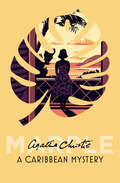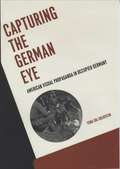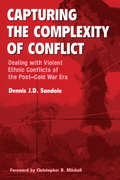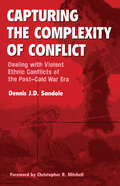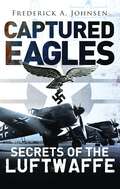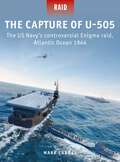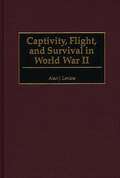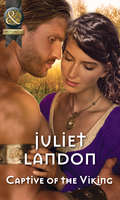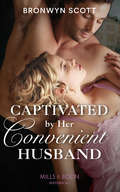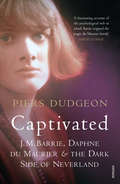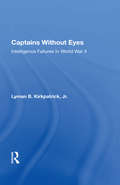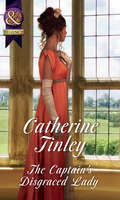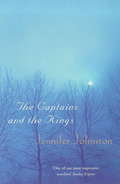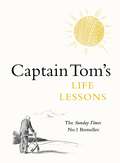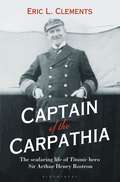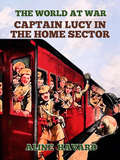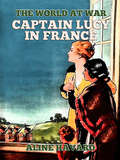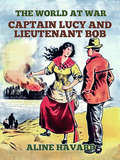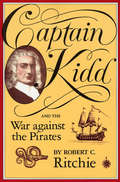- Table View
- List View
A Caribbean Mystery (Miss Marple #10)
by Agatha ChristieAn exotic holiday for Miss Marple is ruined when a retired major is killed…
Cargo Crime: Security and Theft Prevention
by John J. CoughlinCargo crime including theft, fraud, and the passage of contraband through commercial shipping lanes poses an enormous threat to security and the economy. By understanding the current methods and operations of those who attack the supply chain, industry professionals can design effective security plans and law enforcement can properly investigate th
Capturing the German Eye: American Visual Propaganda in Occupied Germany
by Cora Sol GoldsteinShedding new light on the American campaign to democratize Western Germany after World War II, Capturing the German Eye uncovers the importance of cultural policy and visual propaganda to the U.S. occupation. Cora Sol Goldstein skillfully evokes Germany’s political climate between 1945 and 1949, adding an unexpected dimension to the confrontation between the United States and the USSR. During this period, the American occupiers actively vied with their Soviet counterparts for control of Germany’s visual culture, deploying film, photography, and the fine arts while censoring images that contradicted their political messages. Goldstein reveals how this U.S. cultural policy in Germany was shaped by three major factors: competition with the USSR, fear of alienating German citizens, and American domestic politics. Explaining how the Americans used images to discredit the Nazis and, later, the Communists, she illuminates the instrumental role of visual culture in the struggle to capture German hearts and minds at the advent of the cold war.
Capturing the German Eye: American Visual Propaganda in Occupied Germany
by Cora Sol GoldsteinShedding new light on the American campaign to democratize Western Germany after World War II, Capturing the German Eye uncovers the importance of cultural policy and visual propaganda to the U.S. occupation. Cora Sol Goldstein skillfully evokes Germany’s political climate between 1945 and 1949, adding an unexpected dimension to the confrontation between the United States and the USSR. During this period, the American occupiers actively vied with their Soviet counterparts for control of Germany’s visual culture, deploying film, photography, and the fine arts while censoring images that contradicted their political messages. Goldstein reveals how this U.S. cultural policy in Germany was shaped by three major factors: competition with the USSR, fear of alienating German citizens, and American domestic politics. Explaining how the Americans used images to discredit the Nazis and, later, the Communists, she illuminates the instrumental role of visual culture in the struggle to capture German hearts and minds at the advent of the cold war.
Capturing the Complexity of Conflict: Dealing with Violent Ethnic Conflicts of the Post-Cold War Era
by Dennis J. SandoleFirst Published in 1999. Routledge is an imprint of Taylor & Francis, an informa company.
Capturing the Complexity of Conflict: Dealing with Violent Ethnic Conflicts of the Post-Cold War Era
by Dennis J. SandoleFirst Published in 1999. Routledge is an imprint of Taylor & Francis, an informa company.
Captured Eagles: Secrets of the Luftwaffe
by Frederick A. JohnsenThe growth in size, lethality, and technology of the German Luftwaffe was of concern to some defense planners in the United States before American entry into the war. Learning about the Luftwaffe became a significant effort once the conflict broke out in Europe. From defectors with German aircraft to battlefield trophies and combat crew reports, the race to understand German aero technology took on sometimes heroic proportions. After the war, German technology infused American aerospace developments in many ways: German ribbon parachutes were evaluated for high-speed bailouts; sweptwing leading edge slat technology benefited the F-86 Sabre; overall comprehension of sweptwing benefits to fast jet aircraft was validated; pulse jet V1s and supersonic V2 rockets boosted American drone weapon, ballistic missile, and space exploration efforts. In this volume Frederick A. Johnsen traces that path of discovery.
The Capture of U-505: The US Navy's controversial Enigma raid, Atlantic Ocean 1944 (Raid)
by Mark LardasU-505 was the first enemy warship the US Navy captured at sea since 1812. This is a new account of how Captain Gallery planned and executed the raid on his own initiative, and how his success almost endangered the war against the U-boats.On June 4, 1944 a US Navy antisubmarine task group in the Atlantic captured an enemy U-boat on the high seas. It was not the first time the Allies had taken a German U-boat as a prize, but the capture of U-505 was different. Captain Gallery and his Task Group 22.3 devised a risky plan to capture scuttled U-boats.This book analyses in detail Gallery's dangerous strategy, using contemporary sources to explore why he thought the reward was worth the risk: instead of attempting to sink the next U-boat that surfaced among them, a destroyer escort would send off its whaleboat. Everyone else was to smother the U-boat with light gunfire to encourage its crew to abandon quickly. Unaware that the Allies had already cracked the German's codes and the capture of a U-boat could endanger that secret, Gallery hoped to capture the vessel's codes and coding equipment to read U-boat message traffic. The plan culminated in the capture of U-505 in early June, which nearly caused the exposure of the Bletchley Park codebreaking secret. Featuring contemporary photographs, specially commissioned artwork and 3D maps, this book is a fascinating exploration of one of the most controversial and dangerous raids, which could have changed the outcome of World War II as we know it.
The Capture of U-505: The US Navy's controversial Enigma raid, Atlantic Ocean 1944 (Raid)
by Mark LardasU-505 was the first enemy warship the US Navy captured at sea since 1812. This is a new account of how Captain Gallery planned and executed the raid on his own initiative, and how his success almost endangered the war against the U-boats.On June 4, 1944 a US Navy antisubmarine task group in the Atlantic captured an enemy U-boat on the high seas. It was not the first time the Allies had taken a German U-boat as a prize, but the capture of U-505 was different. Captain Gallery and his Task Group 22.3 devised a risky plan to capture scuttled U-boats.This book analyses in detail Gallery's dangerous strategy, using contemporary sources to explore why he thought the reward was worth the risk: instead of attempting to sink the next U-boat that surfaced among them, a destroyer escort would send off its whaleboat. Everyone else was to smother the U-boat with light gunfire to encourage its crew to abandon quickly. Unaware that the Allies had already cracked the German's codes and the capture of a U-boat could endanger that secret, Gallery hoped to capture the vessel's codes and coding equipment to read U-boat message traffic. The plan culminated in the capture of U-505 in early June, which nearly caused the exposure of the Bletchley Park codebreaking secret. Featuring contemporary photographs, specially commissioned artwork and 3D maps, this book is a fascinating exploration of one of the most controversial and dangerous raids, which could have changed the outcome of World War II as we know it.
Captivity in War during the Twentieth Century: The Forgotten Diplomatic Role of Transnational Actors
by Marcel Berni Tamara CubitoThis book offers new international perspectives on captivity in wartime during the twentieth century. It explores how global institutions and practices with regard to captives mattered, how they evolved and most importantly, how they influenced the treatment of captives. From the beginning of the twentieth century, international organisations, neutral nations and other actors with no direct involvement in the respective wars often had to fill in to support civilian as well as military captives and to supervise their treatment. This edited volume puts these actors, rather than the captives themselves, at the centre in order to assess comparatively their contributions to wartime captivity. Taking a global approach, it shows that transnational bodies - whether non-governmental organisations, neutral states or individuals - played an essential role in dealing with captives in wartime. Chapters cover both the largest wars, such as the two World Wars, but also lesser-known conflicts, to highlight how captives were placed at the centre of transnational negotiations.
Captivity, Flight, and Survival in World War II
by Alan LevineA collection of prisoner of war and concentration camp survivor stories from some of the toughest World War II camps in Europe and the Pacific, this book details the daring escapes and highlights the fundamental aspects of human nature that made such heroic efforts possible. Levine takes a comprehensive approach, including evasion efforts by those fleeing before the enemy who never reached formal prisoner of war camps, as well as escapes from ghettoes and labor camps.Levine pays particular attention to dramatic escapes by small boat. Many are not widely known, although some were made over vast distances or in fantastically difficult conditions from enemy-occupied areas. Accounts include attempts at freedom from both German and Japanese prisoner of war camps, stories that reveal much about the conditions prisoners endured. Some of these escapes are far more amazing than the famed Great Escape from Stalag Luft III. German and Austrian prisoners also recount their amazing flights from India to Tibet and Burma. This study challenges some ideas about behavior in extreme situations and casts interesting light on human nature.
Captive Of The Viking: Claiming His Desert Princess; Bound By Their Secret Passion; The Wallflower Duchess; Captive Of The Viking (Mills And Boon Historical Ser.)
by Juliet LandonTaken in revenge!
Captivated By Her Convenient Husband (Allied at the Altar #4)
by Bronwyn Scott‘ Looks like I’ve come home just in time.’ The Duke’s son returns!
Captivated: J. M. Barrie, Daphne Du Maurier and the Dark Side of Neverland
by Piers DudgeonJ. M. Barrie has long been a controversial figure; as D. H. Lawrence observed in 1921, 'Barrie has a fatal touch for those he loves. They die'. The five nervous breakdowns, two suicides, one attempted suicide and numerous deaths that are associated with him blacken the reputation of a man adored by generations of children.However, what is less well known is that Barrie's malign influence grew out of his infatuation with the du Maurier family, particularly with the hypnotist, George du Maurier, creator of Svengali; with George's daughter and grandsons (models for the Darlings in Peter Pan); and with his enigmatic granddaughter, Daphne du Maurier, author of Rebecca and Barrie's final victim, whose life and work can never again be considered without reference to 'Unlce Jim'.
Captains Without Eyes: Intelligence Failures In World War Ii
by Lyman B Kirkpatrick JrWritten by a former Inspector General and Executive Director of the CIA. It describes the role of the failure in gathering and analyzing intelligence behind Barbarossa (German attack on Russia), Pearl Harbor, the 1942 Allied landing at Dieppe, France, the "Market Garden" assault on Arnhem ("A Bridge Too Far"), and the Battle of the Bulge.
Captains Without Eyes: Intelligence Failures In World War Ii
by Lyman B Kirkpatrick JrWritten by a former Inspector General and Executive Director of the CIA. It describes the role of the failure in gathering and analyzing intelligence behind Barbarossa (German attack on Russia), Pearl Harbor, the 1942 Allied landing at Dieppe, France, the "Market Garden" assault on Arnhem ("A Bridge Too Far"), and the Battle of the Bulge.
The Captain's Disgraced Lady: His Convenient Marchioness Compromised By The Prince's Touch The Captain's Disgraced Lady (The Chadcombe Marriages)
by Catherine TinleyWho is Captain Harry Fanton?
The Captains and the Kings: A Novel
by Jennifer JohnstonMr Prendergast, an elderly Anglo-Irishman, is living out his last years in the decaying splendour of his family mansion. As his mind wanders through the gloom he finds it peopled with memories of his neglected wife, his pale shadow of a father, his icily glamorous mother and Alexander, the son she so jealously loved, killed in the First World War. With only his ill-tempered alcoholic gardener left to attend to him, Mr Prendergast is content to pass his days in such ghostly company. Until young Diarmid arrives, keen-eyed and carrot-haired, to disperse the gathering darkness with curiosity, and the promise of friendship.
Captain Tom's Life Lessons
by Captain Tom MooreThe uplifting and heartwarming life lessons from a truly inspirational man, Captain Sir Tom Moore'One small soul like me won't make much difference' Captain Tom________If Captain Tom's big heart and generosity of spirit helped see us through difficult days, this was his parting gift.In Life Lessons, Captain Tom has shared all that he learned from living a full and vibrant life. With cherished anecdotes and his signature humour, these heartening life stories will teach you how to:· Be comfortable with who you are· Keep smiling through the tough times· Walk in someone else's shoes· Keep an open mind· Find your purposeFull of the wit, warmth and wisdom that made him so special, his reflections and guiding principles form a long life, well lived; Life Lessons will be a source of reassurance, hope, and encouragement for generations to come.And a reminder, whenever times are hard, that tomorrow will be a good day.________'Full of the infectious energy that inspired the nation' Daily MirrorPraise for Captain Sir Tom Moore:'A wonderful life story with lessons for us all . . . beautifully written' Daily Telegraph'Engaging . . . His upbeat nature shines through and reminds us how much worse this year would have been without him' Evening Standard'A great book' Good Morning Britain'A beautiful book. We have so much to learn from Captain Sir Tom' Chris Evans
Captain of the Carpathia: The seafaring life of Titanic hero Sir Arthur Henry Rostron
by Eric L. ClementsResponding to Titanic's distress calls in the early hours of 15 April 1912, Captain Arthur Rostron raced the Cunard liner Carpathia to the scene of the sinking, rescued the seven hundred survivors of the world's most famous shipwreck and then carried them to safety at New York. After twenty-five years at sea, the competence and compassion Rostron displayed during the rescue made him a hero on two continents and presaged his subsequent achievements.During the First World War he participated in the invasion of Gallipoli and commanded Cunard's Mauretania as a hospital ship in the Mediterranean and a troop transport in the Atlantic. As her longest-serving master he commanded that legendary vessel in transatlantic passenger service through most of the 1920s. Rostron retired in 1931 as the most esteemed master mariner of his era, celebrated for the Titanic rescue, decorated for his war service, and knighted for his contributions to British seafaring.This account uses newspaper reports, company records, government documents, contemporary publications and memoirs to recount Rostron's seafaring life from his first voyage as an apprentice rounding Cape Horn in sail to his retirement forty-four years later as commodore of the Cunard Line. Set within the context of his times and featuring particulars of the ships in which he served and commanded, this is the first comprehensive biography of Arthur Rostron before, during and after his year as captain of the Carpathia.
Captain of the Carpathia: The seafaring life of Titanic hero Sir Arthur Henry Rostron
by Eric L. ClementsResponding to Titanic's distress calls in the early hours of 15 April 1912, Captain Arthur Rostron raced the Cunard liner Carpathia to the scene of the sinking, rescued the seven hundred survivors of the world's most famous shipwreck and then carried them to safety at New York. After twenty-five years at sea, the competence and compassion Rostron displayed during the rescue made him a hero on two continents and presaged his subsequent achievements.During the First World War he participated in the invasion of Gallipoli and commanded Cunard's Mauretania as a hospital ship in the Mediterranean and a troop transport in the Atlantic. As her longest-serving master he commanded that legendary vessel in transatlantic passenger service through most of the 1920s. Rostron retired in 1931 as the most esteemed master mariner of his era, celebrated for the Titanic rescue, decorated for his war service, and knighted for his contributions to British seafaring.This account uses newspaper reports, company records, government documents, contemporary publications and memoirs to recount Rostron's seafaring life from his first voyage as an apprentice rounding Cape Horn in sail to his retirement forty-four years later as commodore of the Cunard Line. Set within the context of his times and featuring particulars of the ships in which he served and commanded, this is the first comprehensive biography of Arthur Rostron before, during and after his year as captain of the Carpathia.
Captain Lucy In The Home Sector (The World At War)
by Aline HavardExcerpt: "If the young people who read this last story of Lucy Gordon’s army life are disappointed that the end of the war does not bring her home to America they cannot possibly be as disappointed as she herself. She hoped that the war had really finished with the armistice but, like lots of us, she found that there was a great deal left to do that she had not counted upon. Peace was slow in coming, and the American army overseas had its hands as full trying to hasten it as all America on this side had, and still has, in trying to get back to peace-time ways. The tangle of affairs in war-swept Europe is more than Lucy can understand, though she sees a little of that great unrest, and catches a glimpse of its hidden dangers, even in the Home Sector. She does what she can to help, generously, and, though peace is not come and America is still distant, she and Bob and all the Gordon family find happiness together, and look forward with brave confidence to the glorious future of the dear country to which they will before long be homeward bound."
Captain Lucy in France (The World At War)
by Aline HavardExcerpt: "To those who made friends with Lucy Gordon on Governor’s Island it will seem a great change to find her, in this second story, so far away from home. She is only one of thousands, though, to whom a few months of the great war brought more changes than they ever thought could be crowded into a lifetime. Lucy can look back over less than a year to her old life at the army post in New York Harbor before the Colonel was ordered overseas. To that brief summer time when the Gordon family was united during her brother Bob’s West Point graduation leave, and to the dark days of the winter of 1917 when Bob was in a German prison. Even then Lucy never lost hope, and her brave confidence was gloriously rewarded with Bob’s freedom. But in those dreadful weeks of waiting she outgrew her childhood, as though even in that pleasant home on Governor’s Island she knew that peace and content could never come back to her and to those she loved until America had fired her final shot at Germany’s crumbling lines. She could not guess what lay before her,—what old friends she was to meet again in strange new places. Yet she had resolved, even before she had any hope of crossing to the other side, that, come what might, she would serve in her own way as steadfastly as her father served, as valiantly as Bob."
Captain Lucy and Lieutenant Bob (The World At War)
by Aline HavardExcerpt from Captain Lucy and Lieutenant Bob: The war is as yet only beginning for Lucy Gor don, and the old, pleasant times are just ending, but, like every other girl in America, she is trying hard to find the courage and cheerfulness which have never yet been wanting in our Service and which are going to help America to win.
Captain Kidd and the War against the Pirates
by Robert C. RitchieThe legends that die hardest are those of the romantic outlaw, and those of swashbuckling pirates are surely among the most durable. Swift ships, snug inns, treasures buried by torchlight, palm-fringed beaches, fabulous riches, and, most of all, freedom from the mean life of the laboring man are the stuff of this tradition reinforced by many a novel and film. It is disconcerting to think of such dashing scoundrels as slaves to economic forces, but so they were—as Robert Ritchie demonstrates in this lively history of piracy. He focuses on the shadowy figure of William Kidd, whose career in the late seventeenth century swept him from the Caribbean to New York, to London, to the Indian Ocean before he ended in Newgate prison and on the gallows. Piracy in those days was encouraged by governments that could not afford to maintain a navy in peacetime. Kidd’s most famous voyage was sponsored by some of the most powerful men in England, and even though such patronage granted him extraordinary privileges, it tied him to the political fortunes of the mighty Whig leaders. When their influence waned, the opposition seized upon Kidd as a weapon. Previously sympathetic merchants and shipowners did an about-face too and joined the navy in hunting down Kidd and other pirates. By the early eighteenth century, pirates were on their way to becoming anachronisms. Ritchie’s wide-ranging research has probed this shift in the context of actual voyages, sea fights, and adventures ashore. What sort of men became pirates in the first place, and why did they choose such an occupation? What was life like aboard a pirate ship? How many pirates actually became wealthy? How were they governed? What large forces really caused their downfall? As the saga of the buccaneers unfolds, we see the impact of early modern life: social changes and Anglo-American politics, the English judicial system, colonial empires, rising capitalism, and the maturing bureaucratic state are all interwoven in the story. Best of all, Captain Kidd and the War against the Pirates is an epic of adventure on the high seas and a tale of back-room politics on land that captures the mind and the imagination.
